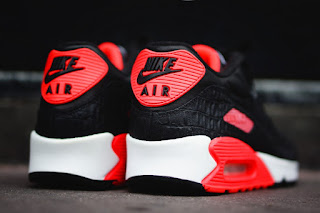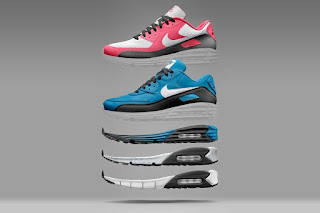Nike Sportswear Presents: Yué Wu on Air
2016年3月22日星期二
YUÉ WU ON AIR
Paris-based artist Yué Wu doesn't stay still. Between traveling the world for inspiration, exhibitions and projects, Wu rarely slows down long enough to reflect on how he's turned his passion into a profession. But even when his head is in the clouds, he maintains humility with his feet firmly grounded—and usually dressed in a pair of Air Max.
AIR SUPERIORITY – NIKE TECH OUT THE AM 90
AIR SUPERIORITY – NIKE TECH OUT THE AM 90
First up it’s the Air Max Lunar 90, harnessing the lightweight and responsive Lunarlon cushioning foam in the sole unit, the classic Air bag remains hero in the heel. Up top it’s a sealed seem situation with a variety of materials coming together real nice. Stay tuned for a flurry of colourways releasing through the year.
Next is the Air Max 90 Jacquard, more of a fashion vibe, the tightly woven textile reminds us of Flyknit and leaves the shoe open for countless colourway possibilities. The recent London Underground edition of these are a fine example of how flexible this material making method is.
Finally the Air Max 90 Ice comes in to chill the vibe. With a translucent sole skin encapsulating Phylon cushioning and translucent Hyperfuse over the fragmented upper, these joints are mos def cold as ice! Although that red one is pretty damn hot to trott.
Nike's classic shoe of the 90s
Air Max flies again as fashion steps back to Nike's classic shoe of the 90s
For designers and celebrities, the famous cushioned trainers are must-haves once more, as the dance music revival harks back to an era of baggy clothes and sports fashion
Dizzee Rascal had a customised pair, basketball star LeBron James an entire line, and clubbers, hip-hop stars and runners throughout the 1990s would rarely be seen without them. Now, on the 25th anniversary of the Air Max, Nike's most famous cushioned trainer, the shoes are enjoying another surge in popularity.
Spotted on the feet of celebrities ranging from Rita Ora to Barack Obama, the bubble-soled shoes have transcended their origins to become a coveted wardrobe staple, embraced across the worlds of fashion and music. "It's not just about any old pair. Labels, styles and specific details are all-important," said Hannah Almassi, fashion editor of Grazia magazine, who said that owning a pair of 90s kicks had become an obsession for trainer fans.
Online retailer Asos reports a significant increase in sales for the latest spring/summer 2013 range. "We have seen a 320% growth on Nike Air Max trainers on the same period for the previous year, making them the casual wardrobe staple," said Nichola Carroll, branded footwear buyer for Asos. "There has been an increase across all trainers. Key styles range from branded retro running styles, such as New Balance, to high- and low-tops, with bold colours proving popular."
David Spencer, product and marketing director for footwear retailer Schuh, said the trend is part of a sports fashion revival: "Nineties sport is the footwear of choice and we have seen a massive uplift in sales for this type of footwear, especially on ladies – where we are seeing girls who aren't traditionally sports customers buying into the trend too."
The 80s was an era of big money, big hair and even bigger phones and Nike executives responded in 1987 with the Air Max shoe and its air bubble visible on the side of the midsole. The design dominated the 1990s and could be spotted in marathons, hip-hop videos and on LP sleeves. A UK forensic science service database study in 2007 found that the Air Max 95 was the favourite footwear for criminalsas it was the most popular footprint at crime scenes.
Another explanation is found in the dance music revival. Clubbers are embracing the original dance music accessory – Air Max 90s – and the 90s deep house sound is very much back. It is defined not only by the music people are listening to, but by the way they are dancing and the clothes they are wearing. Adam Saville, clubs editor for the publication DJ Mag, says that there is now a fascination with the original 90s sound and style as people have access on YouTube and the internet to the history of the genre. "When the future's bleak, there's a fetishisation of what came before. People are looking back as if it was some sort of golden age," he said.
In the early 90s, as the house and rave scene developed, there was a practical element to the shoe. "People were dancing all night or awake 24 hours at a time," said Ben Banks, co-founder of menswear and lifestyle website Oki-ni. "It wasn't like going to a glamorous, luxury nightclub dressed up to the nines, it was very dressed down, people were wearing more comfortable footwear and baggy clothing."
The Air Max creator, Tinker Hatfield, was hired by Nike in 1981 as a "corporate architect". He spent his first four years designing shops and offices, before he was asked to look at shoes. He travelled to Paris searching for inspiration for his first project, and saw the innovative and controversial George Pompidou centre – a large, machine-like building that was "spilling its guts out to the world".
In stark contrast to traditional Parisian architecture, it is an all-exposed construction: the steel structure is visible from the outside, as are giant external escalators, and the colour-coded pipes. Inspired by this, Hatfield began working on a shoe based on the Pompidou.
Not only did Hatfield and his team expose the inside of the structure and the mechanical systems of the shoe, they painted everything in bright colours, creating the hi-tech modern Air Max look.
"When I was growing up I was allowed three pairs of trainers a year. I started wearing Reebok classics because they were only £29.99 and they brought them out in lots of different colours. Then I moved on to Nike," said Tory Turk, 29, curator of an exhibition on trainers in London last year – who was wearing a pair of white and blue Air Max 1s. "When you're 11 or 12, and you're forced to wear uniform at secondary school, your trainers can show your identity. We were allowed to wear black trainers and in gym you could wear any colour you liked. Our generation was wearing them then, and we're wearing them now."
Banks said the high demand was also partly explained by Air Max trainers being about the same price they were 20 years ago. "Air Maxes were £75, £85, £90 in the 90s – they were more expensive then. People see them reissued and look back with a sense of fondness or aspirations that were never fulfilled."
Experts think the trend still has a long way to go. "It's the rule of the 20-year cycle," said Sarah Raphael, online editor at i-D magazine. "The 00s relived the 80s with Dr Martens; the 10s are reliving the 90s and sportswear is back."
AIR MAX 90
The Air Max 90, more correctly known as the Air Max III, was the third instalment in the Max line. Tinker gave the AM90 a faster look with forward tapering panels of synthetic microsuede, duromesh and leather, perfecting the vision he’d started with the Air Max 1. Mythology also plays a role here. The AM90 originally dropped in colours known as laser blue and radiant red and contrary to popular wisdom – despite its nickname – it was never officially referred to as the Infrared until its reissue in 2003. More than two decades since the AM90’s inception, countless retros, collaborations and hybrids have simply escalated demand for this beefy old runner. For many heads, the Infrared 90 is the quintessential Air Max, the most perfect of them all, and it’s hard to argue with that.
订阅:
博文 (Atom)


